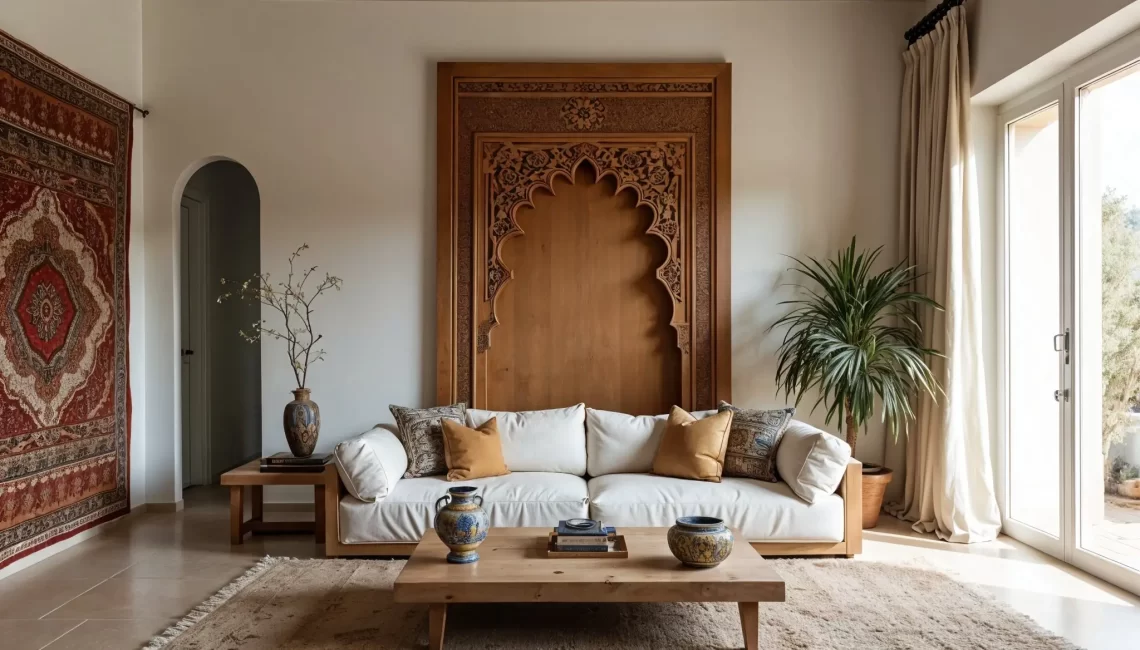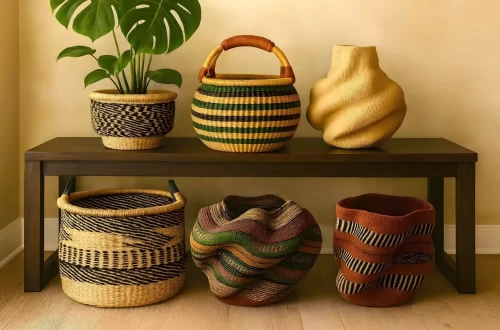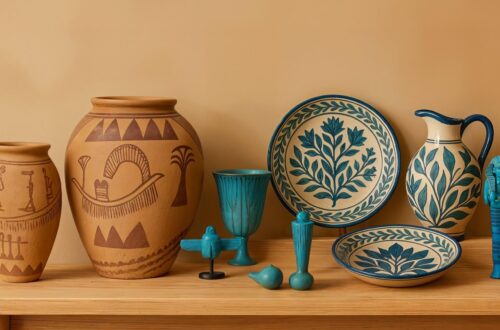Moroccan art rewards attention. The patterns get more complex the closer you get. The longer you look, the more impressive it becomes. Carved plaster ceilings, painted wood beams, zellige tiles: you could truly spend hours staring at a riad or palace around the country.
I’m still learning about its numerous forms, but let me walk you through what I’ve learnt so far: the traditional techniques still practiced today, what makes each piece special, and how to invite it into your own space.
Jump to:
- The Legacy Behind Moroccan Art
- Traditional Moroccan Art Forms
- Modern Moroccan Art
- How to Bring Moroccan Art into Your Home
- Where to Find Authentic Moroccan Art
The Legacy Behind Moroccan Art
Moroccan art draws from layers of cultural influence. Arab, Berber, Andalusian, and African. This mixing happened over centuries, creating something entirely distinct.

A Foundation of Pattern and Geometry
Moroccan art was deeply shaped by Islamic artistic traditions. Religious prohibitions on depicting human or animal forms pushed artists toward abstract expression. So they turned to geometry, and what they created is nothing short of amazing, with patterns based on mathematical principles and symbolic meaning.
Walk through any medina and you’ll see these patterns everywhere. Tile work, carved wood, painted ceilings, woven textiles. Their commitment to geometric precision runs through every art form.
Natural Materials and Traditional Dyes
Moroccan artists work with what the land provides. Cedar wood from the Atlas Mountains. Clay from river valleys. Wool from mountain sheep. Brass and silver for metalwork.

The colors come from natural sources too. Saffron creates golden yellows. Indigo produces deep blues. Pomegranate rinds make warm browns. Henna gives rich oranges and reds.
This connection to place matters. Moroccan art carries the literal substance of Morocco’s landscapes and ecosystems.
Traditional Moroccan Art Forms
Let’s dive into the specific art forms that define Moroccan creativity. They’re living traditions that are still practiced by artisans today.
Zellige: Moroccan Tile Art
Zellige might be the most recognizable form of Moroccan art. These hand-cut ceramic tiles arranged in beautiful geometric patterns across walls, floors, fountains, and facades.
The process is ridiculously complex. Master artisans called mâalems hand-chisel each tile into precise geometric shapes. No two pieces are exactly identical, yet they fit together perfectly in elaborate compositions.
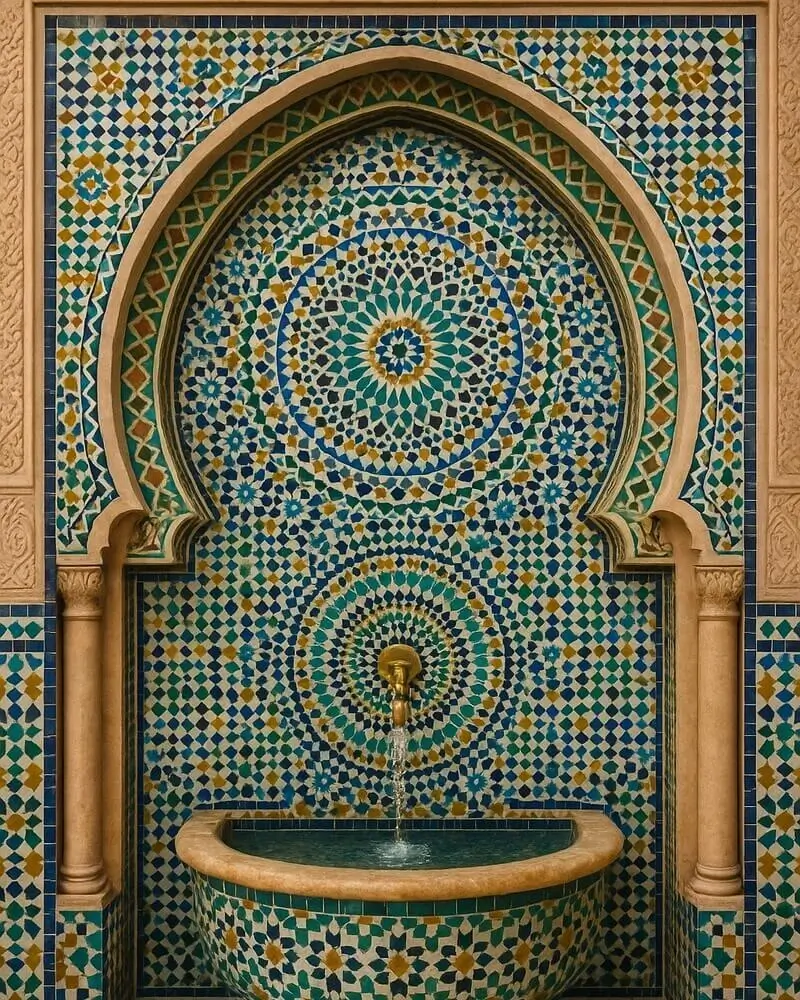
Traditional zellige uses five colors: white, black, green, yellow, and blue. Modern versions expand the palette, but purists stick with the classic combination.
What makes zellige special:
- Entirely handmade — Every tile gets cut, shaped, and placed by skilled hands
- No visible pattern until installed — The design only emerges once all pieces are positioned
- Decades of training required — Master tile cutters spend years perfecting their craft
- Mathematically precise — Complex geometric calculations ensure patterns align perfectly
The best zellige work appears in Fez, Morocco’s artisan capital. Workshops there have produced tilework for palaces and mosques for over a thousand years.
You May Also Like: Moroccan Tiles for Bathroom: A Stunning World of Style
Moroccan Art of Wood Carving
Around Morocco, cedar, walnut, and thuya wood get transformed into carved panels, doors, ceilings, and furniture. The level of detail in their traditional wood carving is staggering.
Carvers work with chisels and gouges, cutting geometric and floral motifs into wood surfaces. Some pieces take months to complete.
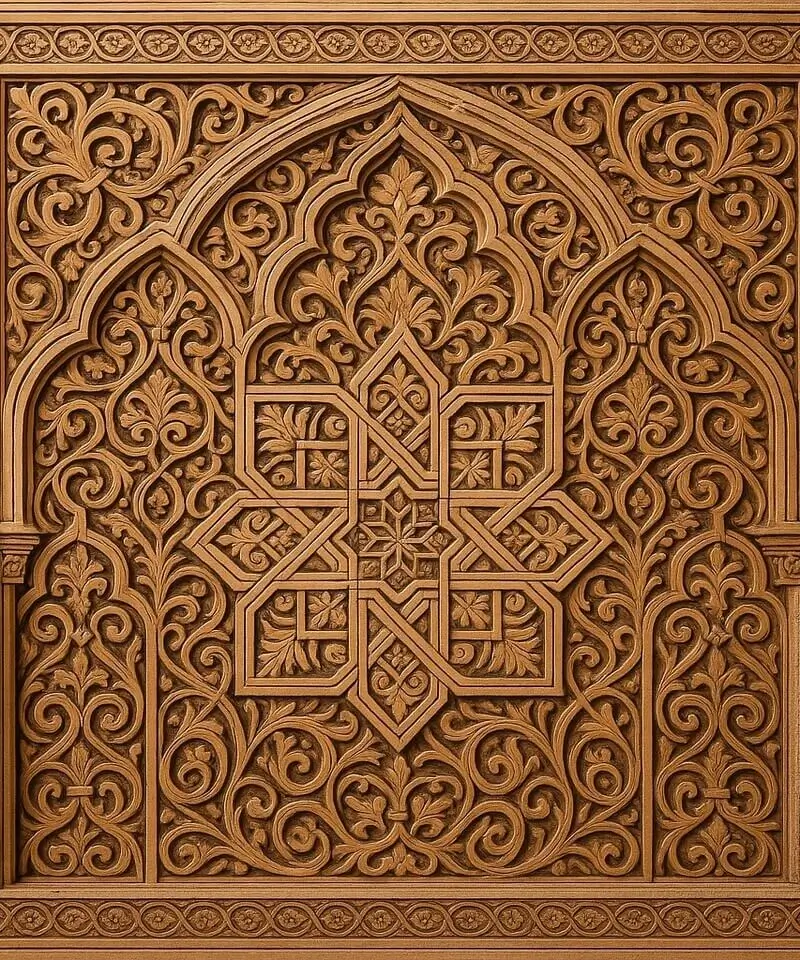
Traditional designs include:
- Arabesques — Flowing, intertwined plant motifs
- Geometric stars — Complex interlocking patterns based on circles and polygons
- Calligraphy — Verses from the Quran or poetry carved in Arabic script
- Muqarnas — Honeycomb-like three-dimensional carved decorations
Painted wood panels add color to the carved designs. Artists use natural pigments to create pieces that are both sculpture and painting. True art!
Moroccan Pottery and Ceramics
Every region in Morocco has its own pottery tradition. Fez produces cobalt blue and white pieces. Safi creates colorful, painted ceramics. Tamegroute makes distinctive green-glazed pottery.
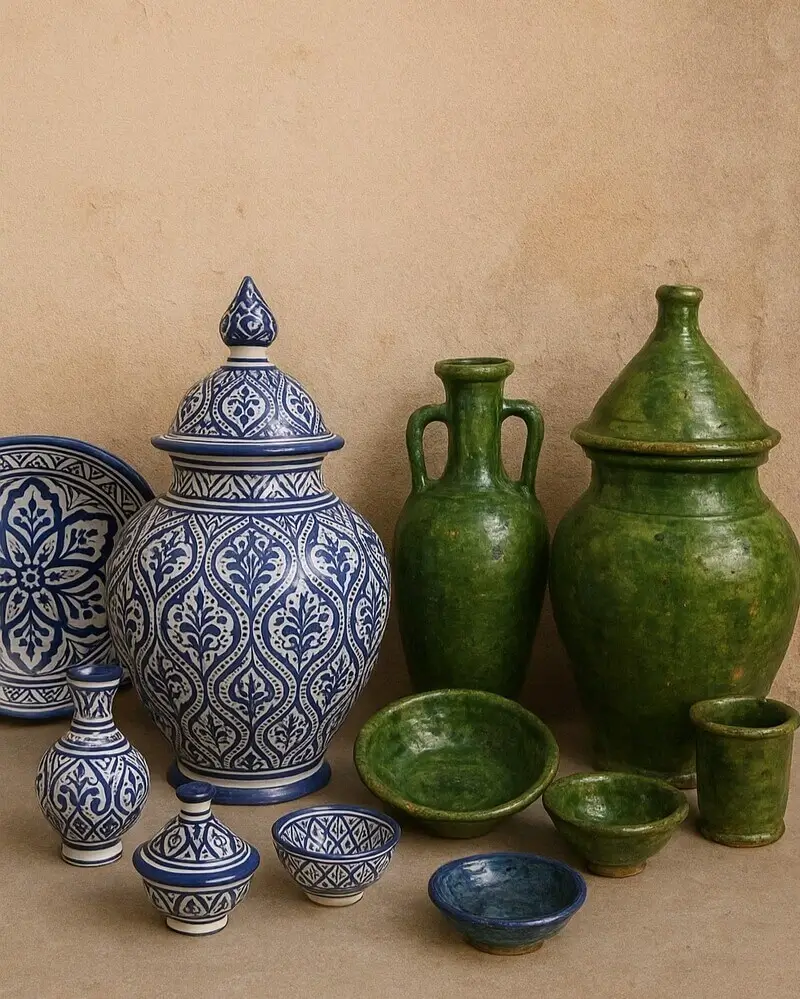
Potters work with local clay, shaping vessels on traditional wheels powered by their feet. After the first firing, they hand-paint delicate designs before applying glaze and firing again.
The painted patterns draw from the same geometric vocabulary as other Moroccan art forms. Interlocking shapes, stylized flowers, and repeated motifs to create visual rhythm across curved surfaces.
But Moroccan pottery isn’t just decorative. It produces tagines that cook slow-braised recipes or plates and bowls that serve food at every meal. Beauty and function live together naturally.
You May Also Like: Egyptian Ceramics: 6,000 Years of Pure Magic
Moroccan Carpet and Textile Art
Last but not least, Moroccan rugs deserve a chapter of their own, but they’re too important to skip here. Berber women have woven carpets for thousands of years, creating pieces that preserve their cultural legacy through abstract symbols.
Different tribes have distinct weaving styles:
- Beni Ourain — Thick, cream-colored wool with black geometric patterns
- Azilal — Vibrant colors and abstract, asymmetrical designs
- Boucherouite — Recycled fabric strips woven into colorful pieces
- Kilim — Flat-woven textiles with geometric patterns
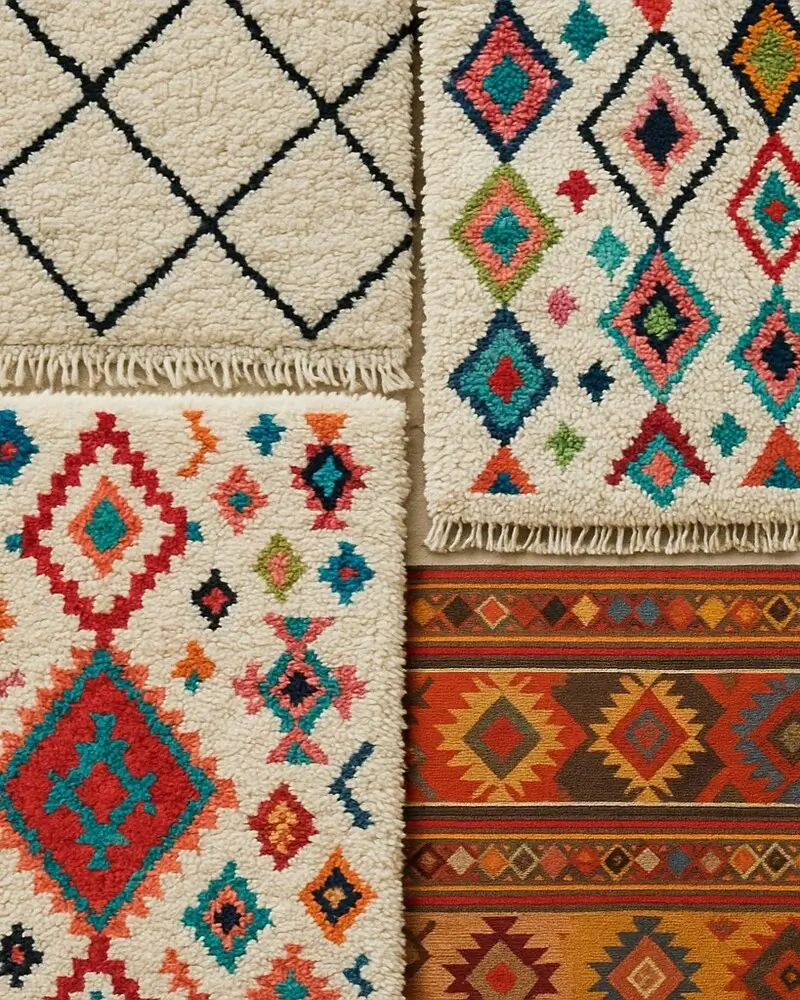
Watching a weaver work is mesmerizing. The knowledge passes from grandmother to granddaughter in an unbroken chain across generations. Beyond home decor, these pieces truly are cultural artifacts and family heirlooms.
You May Also Like: The 5 Moroccan Rug Styles That Make Every Step Special
Modern Moroccan Art
Traditional forms continue strong, but contemporary Moroccan artists are pushing boundaries. The way ancient techniques are being reinvented is truly fascinating.
Moroccan Art in Contemporary Painting and Sculpture
Morocco’s contemporary art scene is thriving. Galleries in Casablanca, Marrakech, and Tangier showcase work that engages with global artistic conversations while remaining rooted in Moroccan identity.
For instance, artists like Hassan Hajjaj blend traditional craft with pop culture. His portraits feature subjects in traditional dress posed against patterned backgrounds made from consumer products. It’s Moroccan art meeting contemporary photography in the most creative ways.
Street Art and Urban Moroccan Art
If you’ve been to Morocco’s cities, you probably noticed how they have become canvases for street artists. Murals appear on medina walls, highway underpasses, and building facades. Some reference traditional patterns, others engage with social issues.
This democratizes Moroccan art, pulling it out of galleries and into public space where it’s accessible to everyone.
The patterns and colors still draw from Morocco’s visual vocabulary. But the scale, placement, and messages are thoroughly contemporary.
How to Bring Moroccan Art into Your Home
You don’t need to live in a riad to enjoy Moroccan art. These pieces are too beautiful to miss out on.
Start with Textiles

Moroccan rugs are the easiest entry point. I love a Boucherouite rug in a family room, but the neutral Beni Ourain carpet will work with any style, adding elegance and warmth.
Next to that, throw pillows made from vintage Moroccan textiles will bring pattern and color without overwhelming a space. Mix them with solid cushions on your sofa for layered interest.
Add Moroccan Art Through Ceramics
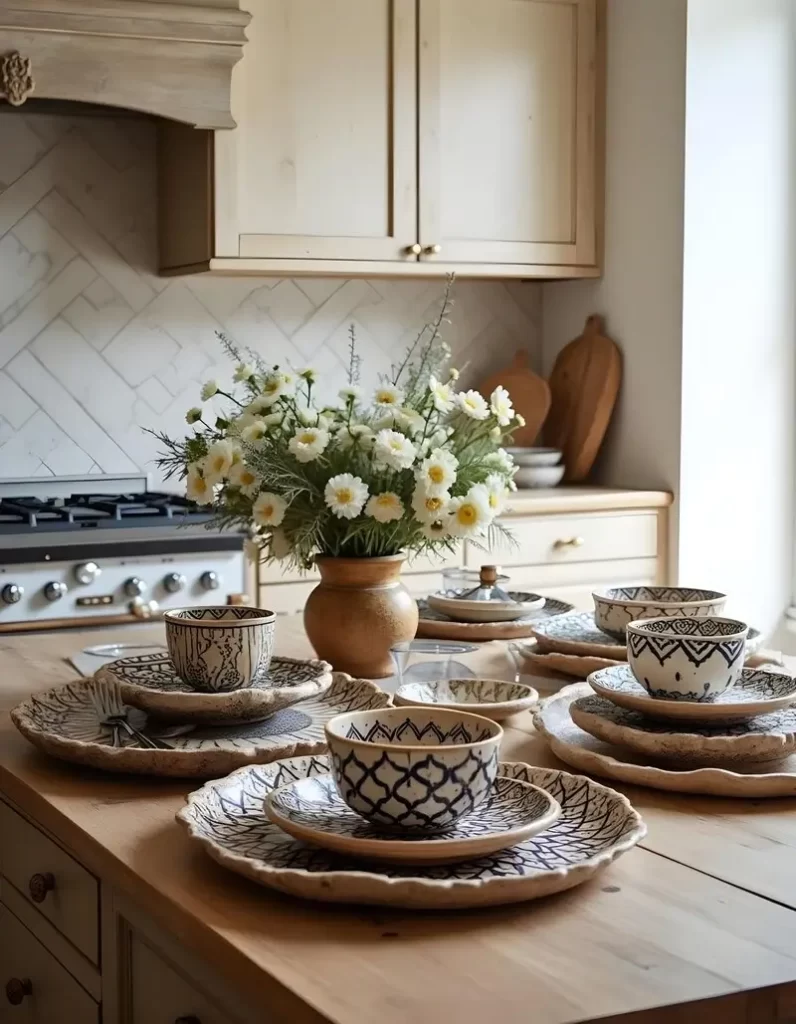
Moroccan pottery makes everyday objects special. Use a painted ceramic bowl for fruit. Display plates on open shelving. Serve dinner on hand-painted dishes.
The patterns and colors bring that distinctly Moroccan energy without requiring major design changes. Plus, these pieces are functional, and that gives me extra pleasure while using them every day.
Display Art Pieces as Focal Points
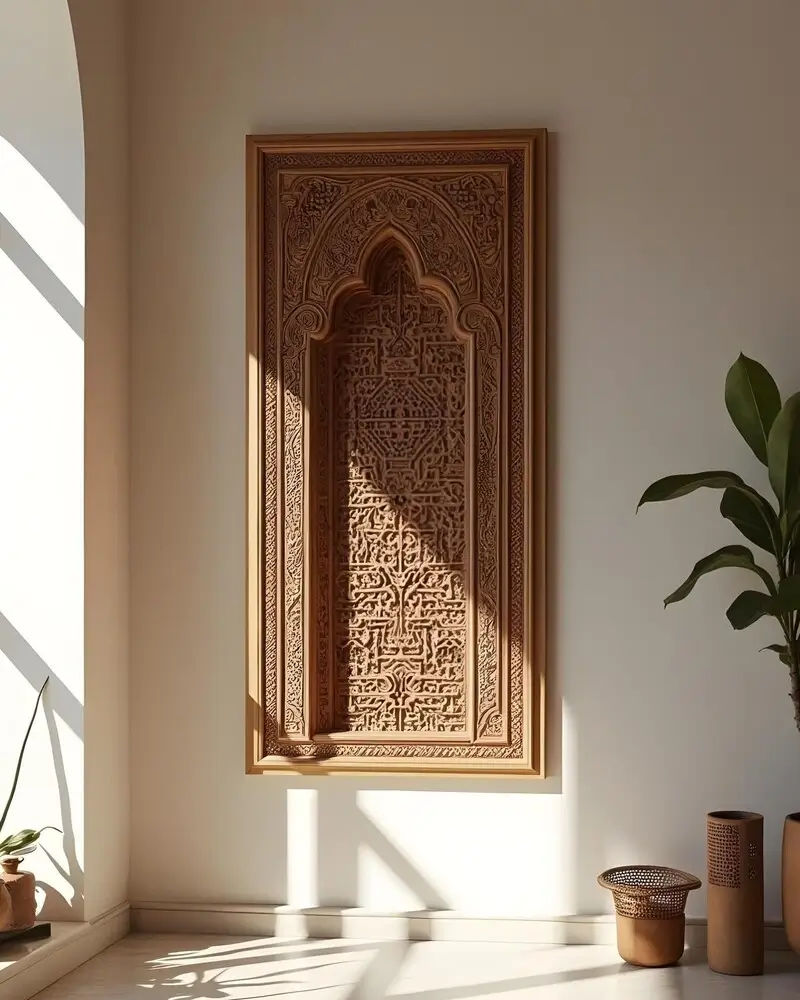
Treat exceptional pieces like the art they are. A carved wood panel mounted on the wall becomes sculpture. A large ceramic vessel displayed on a pedestal commands the room.
Give these pieces the space to be admired.
You May Also Like: Moroccan Interior Design Secrets: Beauty in the Details
Where to Find Authentic Moroccan Art
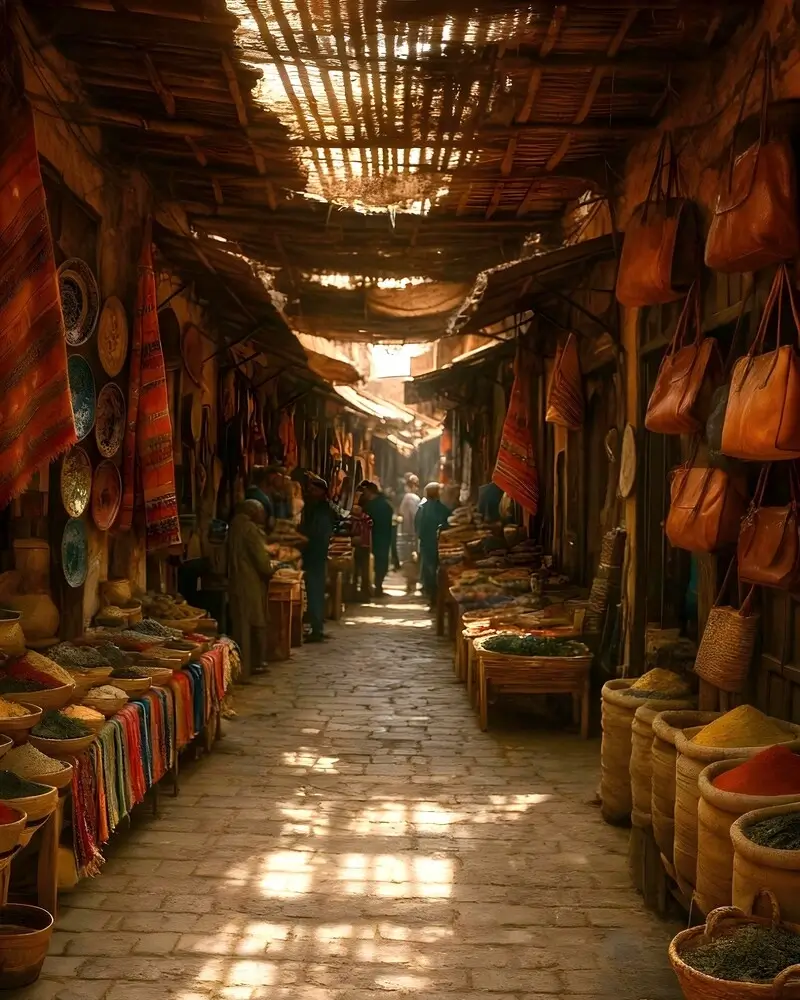
Shopping in Morocco
The souks remain the best source for authentic pieces. Fez, Marrakech, and Essaouira all have extensive artisan quarters where you can watch items being made.
Bargaining is expected and part of the experience. Start at half the asking price and negotiate from there. Take your time, drink tea, build rapport with sellers.
For high-quality pieces, visit established cooperatives. They ensure fair prices for artisans and maintain quality standards.
Online Sources for Moroccan Art
Several platforms now connect artisans directly with international buyers. This supports craftspeople while giving you access to authentic work. Examples include:
- Salam Hello for stunning rugs
- Dounia Home for stunning modern light fixtures
- Latitude 31n for more Boho style items
Look for sellers who provide information about the artists and techniques. Transparency indicates authenticity and ethical practices.
Why Moroccan Art Continues to Captivate
Moroccan art works because it balances opposing forces perfectly. Complexity and clarity. Pattern and unity. Tradition and innovation.
The geometric precision satisfies something deep in how humans perceive beauty. We’re drawn to pattern, to symmetry, to the interplay of repetition and variation.
But there’s also the human element. Knowing each piece was made by hand, that it represents years of training and centuries of tradition, adds something special.
Similar dynamics exist across African artistic traditions. Whether you’re looking at Ethiopian church paintings, Nigerian bronze casting, or South African beadwork, you find that same commitment to craftsmanship, pattern, and cultural continuity.
Moroccan art teaches us that beauty doesn’t have to choose between form and function. That tradition can evolve without losing its essence. And that patience and skill create objects worth treasuring for generations.

